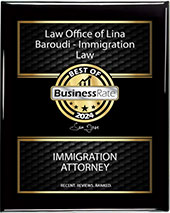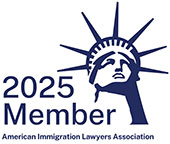Acquisition of U.S. citizenship at birth by a child born abroad depends on the year of birth of the child and the marital status of the parent(s) at the time of the child’s birth. Any U.S. citizen who has a child while outside of the United States must take steps to document their child’s citizenship status if the child is, indeed, a U.S. citizen
A Consular Report of Birth Abroad (CRBA) is the official certification showing that a child born overseas is a U.S. citizen from birth. Parent(s) must make an application for a CRBA at the U.S. Embassy or Consulate in the country where they, or the child, are residing.
Getting a CRBA is a crucial part of securing the rights and protections granted to your child as an American citizen. This process is important to understand.
To help you better understand the CRBA application process, our family immigration lawyers will explain everything you need to know about the CRBA application process.
Is My Child Born Abroad Eligible For a CRBA?
Not all children born overseas automatically qualify for a Consular Report of Birth Abroad (CRBA).
For a child to be eligible, the following criteria must be met:
- At least one parent must have been a U.S. citizen when the child was born.
- The U.S. citizen parent must have met physical presence requirements in the U.S. or its territories prior to the child’s birth, typically 5 years total, with 2 of those years after age 14. The specifics depend on the circumstances.
- The child must be the biological or gestational offspring of the U.S. citizen parent or of a non-U.S. citizen parent married to the U.S. citizen parent at the time of birth.
- The child must be under 18 years old when the CRBA application is submitted. If over 18, different procedures apply.
In the application, you will have to prove both your own citizenship as the parent and the child’s relationship to you. Documents like previous U.S. passports, birth certificates, naturalization papers, etc., can serve as proof.
How to Apply for a CRBA
The application process involves submitting forms and documents to a U.S. embassy or consulate. Proper completion and approval results in the issuance of the official CRBA document.
1. Complete the Forms
The first step is to access and fill out all required forms, including Form DS-2029, which is available on the website of the embassy/consulate where you will be applying. Form DS-2029 is the main application form for the CRBA. It will request basic information about the child, parents, and details related to establishing the child’s US citizenship. Don’t forget to prepare the forms for your child’s U.S. passport.
2. Gather Supporting Documents
You will need to gather various documents to submit along with Form DS-2029. These usually include:
- Child’s original birth certificate
- Parent(s)’ proof of US citizenship (passport, previous CRBA, etc)
- Parents’ marriage certificate, if applicable
- Evidence of the US citizen parent’s physical presence in the US prior to the child’s birth
- Divorce/death certificates if prior marriages ended
- Any guardianship or custody affidavits if needed
3. Schedule an Appointment
Once all documents and forms are completed, schedule an appointment online via the embassy/consulate website to submit the application in person.
4. Attend the Appointment and Submit the Application
Attend the appointment and submit the completed DS-2029 form, supporting documents, mailing materials, and application fees. The Embassy staff will review it for completeness.
5. Await Application Review/Approval
The embassy will review the application and contact you if any additional information is required. Once approved, the CRBA will be sent to you using the provided mailing materials.
Is a Consular Report of Birth Abroad the Same as a Birth Certificate?
A CRBA documents that your child is a U.S. citizen since birth, but it does not serve as proof of the child’s legal parents. The CRBA can be used as proof of U.S. citizenship to apply for a passport for your child, a driver’s license, and so on.
How Long Does It Take to Get a Consular Report of Birth Abroad?
Depending on the nationality, the embassy or consulate can take weeks to issue a CRBA. Expedited service is unavailable. So, beware of other internet sites that make such promises. An emergency passport endorsement may be available for emergency travel, like a death in the family.
Can I Change the Information Listed on a Consular Report of Birth Abroad?
Yes. The information on an existing CRBA can potentially be amended or the document replaced by submitting a request to the U.S. Department of State. To do this, the CRBA holder (if over 18) or an authorized individual must send:
- A notarized letter with the proposed changes and identifying details like full name, passport info, CRBA number, etc.
- Original supporting documents like court orders for name changes.
- Photo ID and a $50 check or money order payable to the Department of State.
- For replacements, the original CRBA does not need to be submitted.
The request should be mailed to the address provided by the Department of State. They will review the amendment/replacement request and process it accordingly. Proper documentation is required to change or replace a CRBA.
Get Legal Help Obtaining a CRBA in San Jose
As you can see, getting a Consular Report of Birth Abroad for your child involves an intricate application process. Trying to navigate all the requirements for documents, fees, interviews, and more on your own can be challenging.
That’s why it can greatly help to have the assistance of an experienced immigration law firm like the Law Office of Lina Baroudi. Our team of dedicated attorneys and professionals can help you handle CRBA and other citizenship-related applications. Contact us today for a consultation.





















